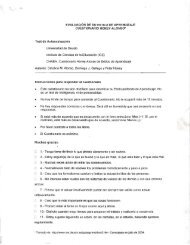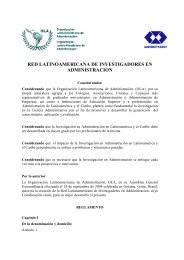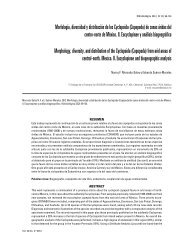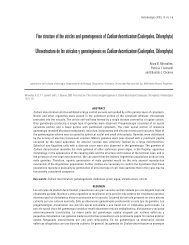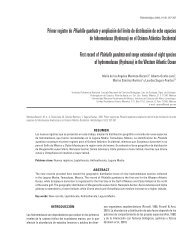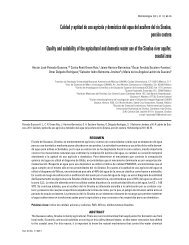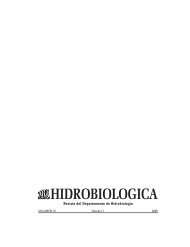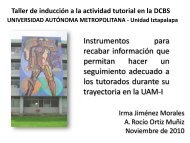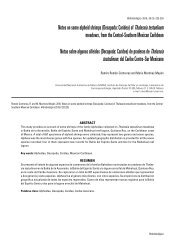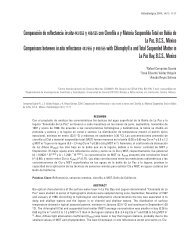21 (1): 26-33
21 (1): 26-33
21 (1): 26-33
Create successful ePaper yourself
Turn your PDF publications into a flip-book with our unique Google optimized e-Paper software.
Records caridean shrimps western Mexico 27possible (i.e., in the intertidal, in shallow water, or with roboticdevices in deep water), which contribute to our knowledge onabundance, behaviour and composition of the flora and fauna.However, collection of specimens in the field still representsthe safest and more adequate way to study the richness ofthe sea.The west coast of Mexico is particularly interesting due tothe confluence of several geographic provinces, including thewarm temperate California Province (under the influence of theCalifornia Current), the Cortés Province (covering the Gulf ofCalifornia and the SW tip of the Baja California Peninsula), witha high degree of endemism, and the tropical waters of the MexicanProvince (south of the Gulf of California to ca. 16°N). To thesouth it continues to the northern end of the Panamic Province(south of 16°N to the Guatemala border) (Brusca & Wallerstein,1979; Brusca, 1980; Hendrickx, 1992; Hendrickx et al., 2005; Espinosa-Pérez& Hendrickx, 2006). This mixture of fauna makes thewest coast of Mexico particularly attractive for distributionalstudies.Decapod crustaceans are undoubtedly one of the bestknown groups of marine invertebrates in the eastern tropicalPacific. Among these, the Caridea has received much attention.We have considerable knowledge of species compositionof this group in distinct habitats in the area and of their largescalegeographic distribution (see Wicksten & Hendrickx, 2003).In many cases, however, we still lack useful information on localgeographic or bathymetric distributions and on the relative importanceof species in their habitat in terms of abundance and trophicrelationships. Also, due to strong pressure on some marinecoastal habitats, it is important to gather records on the presenceof the species for long periods of time. This obviously includes theuse of field samples obtained in the past that have not yet beenstudied.Much information on ranges of decapod crustacean speciesin the eastern tropical region is based on the Allan Hancock PacificExpeditions (1936-1955). More recently, however, collectionsmade by Mexican institutions have considerably increased, allowingfor many new records and new species descriptions (seeBrusca, 1980; Wicksten, 1983; Hendrickx, 1993; Hendrickx et al.2005).This note reports on a series of 24 species of Caridea thatwere collected between 1979 and 2004 in natural ecosystemsalong the west coast of Mexico.Material and MethodsSamples were either collected by hand or with small devices (e.g.,shovel, hand nets) in coastal environments, or aboard the R/V “ElPuma” of the Universidad Nacional Autónoma de México (UNAM)during cruises organized by the Laboratorio de InvertebradosBentónicos, ICML, Mazatlán (SIPCO, CORTES, TALUD cruises) orby other laboratories or institutions (CEEMEX, BIOCAPESS andAA8110 cruises). Unless indicated, material was collected by staffof the Laboratorio de Invertebrados Bentónicos. All the specimensreported herein have been deposited in the Regional Collection ofMarine Invertebrates (EMU), ICML, UNAM, in Mazatlán, Mexico.Abbreviations are: St., sampling station; CL, carapace length (fromorbit to posterior margin of carapace); ovig., ovigerous; coll. collector.Unless it is indicated, specimens were not sexed and notmeasured. To avoid confusion in translating geographic localitieswhere material was collected or previously reported, all nameswere used in their Spanish spelling.Systematic sectionResultsSuperfamilia Pasiphaeoidea Dana 1852Familia Pasiphaeidae Dana 1852Leptochela serratorbita Bate, 1888Material examined.- Bahía de Mazatlán, C10 B/E FC1, St. 3(23°12’13”N, 106°27’<strong>21</strong>”W), 1 specimen, 11/Apr/1980, Van Veengrab, 13 m (EMU-8840-C). Bahía de Mazatlán, C11 B/E FC1, St. 4(23°13’23”N, 106°27’20”W), 1 specimen, 30/Abr/1980 (EMU-8840-A). South of Isla Carmen, CORTES 1, St. 10 (25°58’0”N, 111°7’0”W),4/May/1982, 2 specimens, 30 m (EMU-8844-A). Off Cabo SanMiguel, CORTES 2, St. <strong>21</strong> (28°8’18”N, 112°41’36”W), 1 specimen,13/Mar/1985, 108 m, otter trawl (EMU-8848). Off Banco Gorda, COR-TES 2, St. 57 (23°8’12”N, 109°<strong>26</strong>’42”W), 4 specimens, <strong>21</strong>/Mar/1985,56 m (EMU-8844-B). Bahía de Mazatlán (23°13’N, 106°27”W), dateunknown, 1 specimen, depth unknown (EMU-8840-B).Previous geographic records.- Eastern Pacific from Gulf ofCalifornia, Mexico, to Costa Rica; also in West Atlantic (Wicksten& Hendrickx, 2003).Remarks.-The present records confirm the presence of thisspecies throughout the Gulf of California.Psathyrocaris fragilis Wood-Mason, 1893Material examined.- TALUD XII cruise, St. 29 (19°19’37”N,105°<strong>26</strong>’20”W), 1 specimen, 2/Apr/2008, 1180-1299 m depth, benthicsledge (EMU-8864).Previous geographic records.- Off Peru, between ca. 8°43’Sand 6°13’S (Mendez, 1981). Also known from the Indo-Pacific andthe East Atlantic (Hendrickx & Estrada-Navarrete, 1989).Remarks.- The present record increases the known distributionrange to the north by 25 degrees of latitude.Vol. <strong>21</strong> No. 1 • 2011



